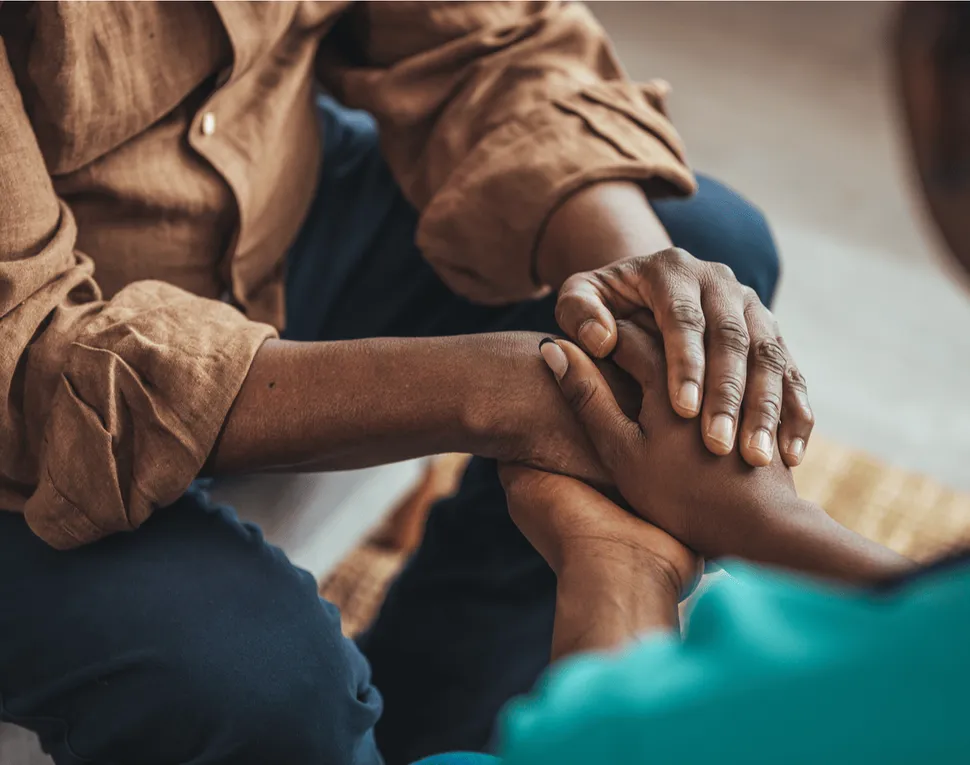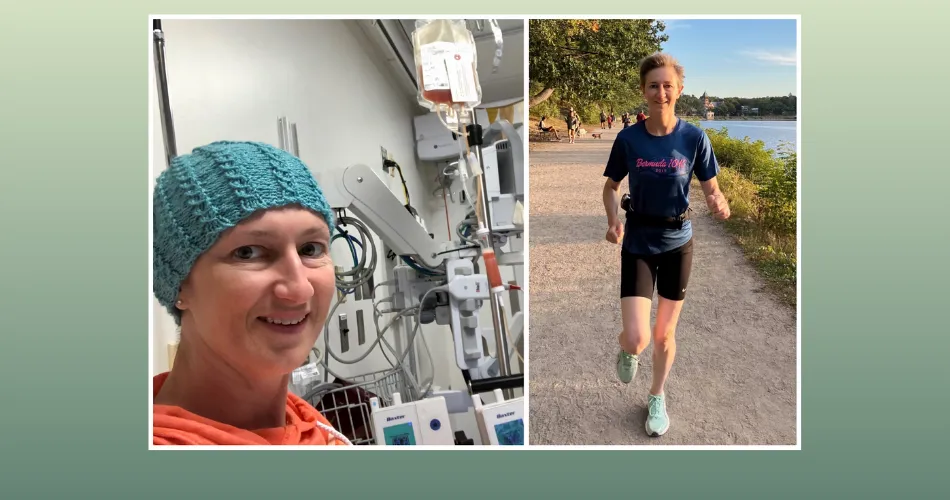Full AML Caregiver Chapter Event: Supporting Your Loved One During and After AML Treatment

Dr. Ashley Leak Bryant joined the AML Caregivers Chapter on March 9th, 2022 to discuss how you as a caregiver can support your loved one during and after AML treatment. In her presentation, she reviews common treatment related symptoms to watch out for and her study evaluating the effectiveness of a palliative care team in coaching patients and caregivers to meet their goals during treatment
Watch the Recording Here:
Dr. Bryant starts by sharing a few facts about AML:
- AML is an aggressive blood cancer that needs to be treated very emergently
- The median age of diagnosis is 68 years old. The median age is increasing as people are living longer lives.
- AML is more common among males (60% of cases) vs females (40% of cases).
- AML is more common in whites compared to blacks or other races.
- AML is diagnosed by a bone marrow biopsy.
It’s important to consider clinical trials during your loved one’s AML treatment journey. These trials can be found at clinicaltrials.gov or HealthTree’s AML Clinical Trial Finder.
Dr. Bryant shares common side effects of AML and AML treatment which include:
- Neutropenia- Having low neutrophils, a type of white blood cell makes it more difficult to fight off infection. Carepartners should be able to recognize the early signs and symptoms of infection so they can help the patient receive early treatment. Establish with your care team clear guidelines on when to go to the clinic vs when to go straight to the emergency room. To prevent infection, take precautions such as mask wearing, hand washing and avoiding sick family and friends.
- Bleeding - Having low platelets makes it difficult for patients to stop bleeding. Safety is so important when platelets are low. Practicing good safety measures at home means making sure there are no throw rugs in the home, wearing shoes when walking around, avoiding bumping toes, refraining from picking scabs or nose. Avoid anything that puts the patient at risk for falling. Fatigue is a sign that red blood cells and platelets are low and the patient is at high risk for bleeding.
- Fever - anything above 104 degrees Fahrenheit or higher is considered a fever. If your loved one’s temperature is higher than this, call your office immediately and talk to your nurse. Then go straight to the emergency room. Mostly likely you will be admitted to the hospital to have a workup done. The purpose of the workup is to figure out why there is a fever and to get a handle on it as quickly as possible. This workup will include a blood culture, a urine sample, a chest xray and possibly a sputum sample if the patient is coughing. Antibiotics will likely be started quickly.
- Infertility - most AML treatments may cause infertility. It’s important to have discussions with your care team if you and your loved one are planning on having children. There are oncofertility educators at many facilities, and you should speak to one before starting treatment. AML drugs can harm a developing baby so it’s also important to use contraception.
Palliative and Collaborative Care Intervention (PACT) at University of North Carolina
Dr. Bryant’s study has been going on for a little over one year now.
In her study, the PACT team is made up of a registered nurse, a physical therapist, a pharmacist, and an occupational therapist. The PACT team enrolls adults over the age of 60 with newly diagnosed AML on the combination of a hypomethylating agent (azacitidine or decitabine) and venetoclax who have a caregiver willing to participate. The goal of the study is to start physical therapy and occupational therapy within the first few days of treatment in addition to having the pharmacist continually review the patient’s medication list.
Once a patient and caregiver are enrolled into the study, they will meet with each member of the PACT team for baseline assessments. The nurse will ask about symptoms, quality of life and cognition. Ocucpational therapy and physically therapy will evaluate functional status (gait, fall risk, what’s concerning about the patient’s physical condition). Afterwards, each member of the care team comes together to talk about their findings. The goal is to be able to present to the patient and carepartner what was found from the assessment and co-create SMART goals that the patient and carepartner can work towards during treatment. The patient and caregiver will complete a brief coaching call each week to check in on the progress toward the SMART goal and discuss the challenges being faced.
SMART is an acronym that stands for:
S- Specific
M- Measureable
A- Attainable
R- Realistic
T- Time-sensitive
Common patient symptoms seen from patients in the PACT study:
-
Getting to and from the hospital every day for treatment
-
Pain
-
Reduced mobility
-
Weakness
-
Fatigue
-
Feeling restricted due to functional decline
Common carepartner symptoms seen from patients in the PACT study:
-
Emotionally overwhelmed
-
Fear
-
Depression
-
Guilt
-
Coordinating schedules with clinic
-
Waiting everywhere you go
-
Being available at all times to take care of the patient
-
Balancing your own life and own work
Dr. Bryant wraps up by stating that progress isn’t possible without patients and their carepartners working together with care teams and research teams. She wants each patient and caregiver who participate in research to know that you are making a difference when involved in a study. Your time and efforts are highly valued. As a healthcare professional, she strives to treat each patient and caregiver with kindness and always practice empathy because what you are going through is extremely difficult.
To Participate in Future AML Caregiver Chapter Events,
Join the AML Caregiver Chapter
Dr. Ashley Leak Bryant joined the AML Caregivers Chapter on March 9th, 2022 to discuss how you as a caregiver can support your loved one during and after AML treatment. In her presentation, she reviews common treatment related symptoms to watch out for and her study evaluating the effectiveness of a palliative care team in coaching patients and caregivers to meet their goals during treatment
Watch the Recording Here:
Dr. Bryant starts by sharing a few facts about AML:
- AML is an aggressive blood cancer that needs to be treated very emergently
- The median age of diagnosis is 68 years old. The median age is increasing as people are living longer lives.
- AML is more common among males (60% of cases) vs females (40% of cases).
- AML is more common in whites compared to blacks or other races.
- AML is diagnosed by a bone marrow biopsy.
It’s important to consider clinical trials during your loved one’s AML treatment journey. These trials can be found at clinicaltrials.gov or HealthTree’s AML Clinical Trial Finder.
Dr. Bryant shares common side effects of AML and AML treatment which include:
- Neutropenia- Having low neutrophils, a type of white blood cell makes it more difficult to fight off infection. Carepartners should be able to recognize the early signs and symptoms of infection so they can help the patient receive early treatment. Establish with your care team clear guidelines on when to go to the clinic vs when to go straight to the emergency room. To prevent infection, take precautions such as mask wearing, hand washing and avoiding sick family and friends.
- Bleeding - Having low platelets makes it difficult for patients to stop bleeding. Safety is so important when platelets are low. Practicing good safety measures at home means making sure there are no throw rugs in the home, wearing shoes when walking around, avoiding bumping toes, refraining from picking scabs or nose. Avoid anything that puts the patient at risk for falling. Fatigue is a sign that red blood cells and platelets are low and the patient is at high risk for bleeding.
- Fever - anything above 104 degrees Fahrenheit or higher is considered a fever. If your loved one’s temperature is higher than this, call your office immediately and talk to your nurse. Then go straight to the emergency room. Mostly likely you will be admitted to the hospital to have a workup done. The purpose of the workup is to figure out why there is a fever and to get a handle on it as quickly as possible. This workup will include a blood culture, a urine sample, a chest xray and possibly a sputum sample if the patient is coughing. Antibiotics will likely be started quickly.
- Infertility - most AML treatments may cause infertility. It’s important to have discussions with your care team if you and your loved one are planning on having children. There are oncofertility educators at many facilities, and you should speak to one before starting treatment. AML drugs can harm a developing baby so it’s also important to use contraception.
Palliative and Collaborative Care Intervention (PACT) at University of North Carolina
Dr. Bryant’s study has been going on for a little over one year now.
In her study, the PACT team is made up of a registered nurse, a physical therapist, a pharmacist, and an occupational therapist. The PACT team enrolls adults over the age of 60 with newly diagnosed AML on the combination of a hypomethylating agent (azacitidine or decitabine) and venetoclax who have a caregiver willing to participate. The goal of the study is to start physical therapy and occupational therapy within the first few days of treatment in addition to having the pharmacist continually review the patient’s medication list.
Once a patient and caregiver are enrolled into the study, they will meet with each member of the PACT team for baseline assessments. The nurse will ask about symptoms, quality of life and cognition. Ocucpational therapy and physically therapy will evaluate functional status (gait, fall risk, what’s concerning about the patient’s physical condition). Afterwards, each member of the care team comes together to talk about their findings. The goal is to be able to present to the patient and carepartner what was found from the assessment and co-create SMART goals that the patient and carepartner can work towards during treatment. The patient and caregiver will complete a brief coaching call each week to check in on the progress toward the SMART goal and discuss the challenges being faced.
SMART is an acronym that stands for:
S- Specific
M- Measureable
A- Attainable
R- Realistic
T- Time-sensitive
Common patient symptoms seen from patients in the PACT study:
-
Getting to and from the hospital every day for treatment
-
Pain
-
Reduced mobility
-
Weakness
-
Fatigue
-
Feeling restricted due to functional decline
Common carepartner symptoms seen from patients in the PACT study:
-
Emotionally overwhelmed
-
Fear
-
Depression
-
Guilt
-
Coordinating schedules with clinic
-
Waiting everywhere you go
-
Being available at all times to take care of the patient
-
Balancing your own life and own work
Dr. Bryant wraps up by stating that progress isn’t possible without patients and their carepartners working together with care teams and research teams. She wants each patient and caregiver who participate in research to know that you are making a difference when involved in a study. Your time and efforts are highly valued. As a healthcare professional, she strives to treat each patient and caregiver with kindness and always practice empathy because what you are going through is extremely difficult.
To Participate in Future AML Caregiver Chapter Events,
Join the AML Caregiver Chapter

about the author
Katie Braswell
Katie joined HealthTree as the Community Director for AML in 2021 and became HealthTree's Director of Education in 2023. Katie is a registered dietitian who is passionate about health literacy and patient empowerment. She loves to cook, travel and spend time with her newborn son, husband and dog.
More on Navigating Your Health
Trending Articles

Get the Latest Acute Myeloid Leukemia Updates, Delivered to You.
By subscribing to the HealthTree newsletter, you'll receive the latest research, treatment updates, and expert insights to help you navigate your health.
Together we care.
Together we cure.
3x Faster.










